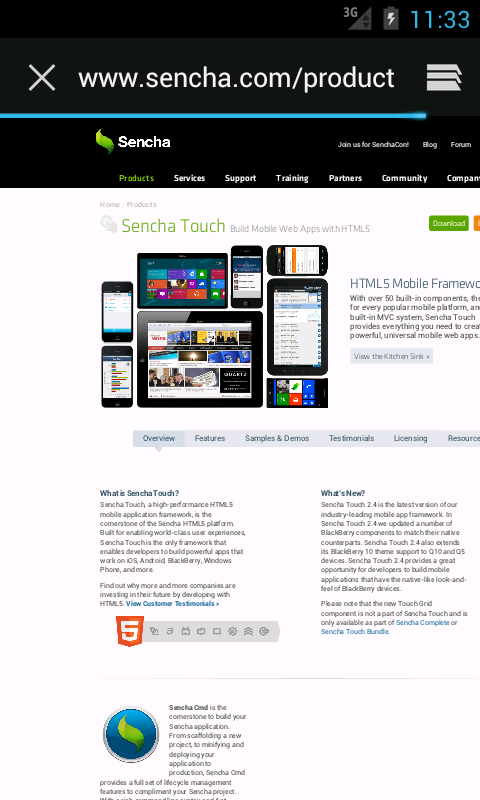Use our product for mobile! See how unreadable we look there!
-
Yesterday I was surveying javascript frameworks for creating application widgets on mobile platform. So I obviously wanted to see how their demos work on a mobile. At least Android for which I have both older device and emulator handy (I just ask Jenkins if I need to build for the other platforms).
Ok, so somebody recommended this Sencha Touch. So I loaded it's homepage on the device. And got this:

Ok, I tried on 4.0 emulator, 480x800 again. And got

the same.Why do they think I'll choose their product for mobile development when they can't even make their own web properly adapt to mobile browser?
Another contender. Here's Kendo-UI web, in portrait and landscape:


See the half of a magnifying glass icon sticking from below the white pane? That's because the white pane is a floating panel and the actual page, with the important Demo button is hidden below it.That was the two commercial frameworks I found. The other three contenders were open-source (Dojo Toolkit, jQuery Mobile, and Mobile Angular UI. For all three the main page came up readable (worst were the toolbar buttons on the Dojo one, but I still could make out the correct one) and their demos worked and looked reasonably well. How do the commercial ones (further complication: Sencha Touch claims to provide free commercial license with some limitations, but when I click through to the, generic, FAQ it no longer looks like that) hope to persuade they are better?
-
I was surveying javascript frameworks
TRWTF!
You know what's more sad? What you describe is exactly the same scenario that I found 4 or 5 years ago. The contenders were the same and they all sucked. Use a responsive design and forget about this frameworks because they all suck! If you still want to, jQuery mobile is the one you can so something and maintain sanity.
-
FWIW, we use Kendo and Bootstrap. Simultaneously. In the same product. They actually play very nicely together and complement each other.
Of course, in the entire history of ever we have not had a single production mobile user because it's a corporate intranet app and the cheapskates refuse to get a smartphone or cellular tablet for the on-call rotation (and it handles numerous PII, HIPPA, PCI, etc. so ain't nobody authorizing private devices).
Works really fantastic on real computers, though.
-
Yeah, I also made a few internal Sencha web apps for corporate stuff and it works very well. But the mobile thing is... Ugh!
-
At my company we don't do responsive because "the UI guys can't design something that would work as well on a phone as on a desktop". My suggestion of "hire better UI designers?" fell on deaf ears.
-
"hire better UI designers?"
Your bossWhoever is in charge of hiring UI designers heard:"hire more expensive UI designers?"
-
Eh, my boss isn't their boss. Their boss(^n) is the Marketing director. Mine is the Information Solutions director. So...
-
Fair do's, I made an edit to my original assertion...
-
Our one design-minded developer left recently to marry his long-distance girlfriend. I think we're filling his spot with a Marketing guy who has never used CSS before in his life but is willing to learn. I suspect this will continue to be out of our reach for the foreseeable future :/
-
Remind me when I'm at my work computer to send you some "iPhones".
The iPhone 4 has a 320x356 (effective) 4 in2 "above the fold" area. When the designer at my old job handed me "mobile-responsive" designs, I put them in Illustrator adjusted to that size and slap them on a picture of an iPhone and print them out. Then I challenged him to read the text, and tap the links without fat-fingering. Usually he figured it out after that.
I carried that file with me to my new job. We'll see if it's needed again.
-
From my eavesdropping, for our new rewrite project, phones are explicitly not being considered in-scope, but tablets are. Which, to be fair, the kind of software we make is not something you'd want on a phone. Our consumer product has a one-page jQuery-mobile app at m.product.com as opposed to the full-size multi-page app at product.com
-
You know what's more sad? What you describe is exactly the same scenario that I found 4 or 5 years ago. The contenders were the same and they all sucked.
Thanks.
You don't seem to mention the Dojo; did you ever look at that?
I didn't try playing with them yet. So far we were doing only native development, but we may have some task that could be easier with HTML5 and Cordova (former PhoneGap) so I was scouting for options first.
At my company we don't do responsive…
This is going to be a "native" app, but it's pretty trivial data display/entry and given how the native gui is completely different on each platform we thought about saving time by doing it in HTML+JS instead. So it has to resemble native GUI.
-
From my eavesdropping, for our new rewrite project, phones are explicitly not being considered in-scope, but tablets are. Which, to be fair, the kind of software we make is not something you'd want on a phone.
What about phablets?

OK, that's a little mischievous, but the core point is that there seems to be a fair space between what phones are usually thought of as being and what tablets are thought of as being. (My device claims to be 1280×720, and the fat finger effect isn't quite so overwhelming with a 5.5" device…)
-
Yeah, but our major product is a B2B product meant to be used in the workplace. A lot of our clients are moaning about having to upgrade from IE6. The only reason we care about tablets is that our most cutting-edge clients are now using them at the point of sale and are asking if we can put our web app on a tablet, which honestly makes no sense but there you go, if it gives us a leg up...
-
which honestly makes no sense
Tablets are probably a lot cheaper than the hardware they were using before. The power of mass manufacturing! It also lets them pretend to be cooler than they really are, which Sales seems to think is a good idea.
We've been investigating using tablets for years for taking out on sites where people are digging holes in the ground to fix pipes. Sure, the tablets aren't nearly as robust as the ruggedized PCs that were part of the original brief, but they're so enormously cheaper and more available, while actually having the hardware needed (GPS, wire-free data connection) to be useful for plotting what is there. As bonus, the guys on (in?) the ground will be able to take a photo of what they actually find, and I've never seen a ruggedized laptop with a camera*. After all, just because the plans back at base say one thing doesn't mean at all that what they've actually got is the same thing. And if it breaks? Get another, put the custom app on it; the price of a non-branded tablet (or phablet) is so low that purchasing extra ruggedness is a waste of money, as you can get 10 or more for the same cash as one heavy-duty laptop.
* Not that they can't exist. Just never seen one.
-
At the time, Dojo was irrelevant on that space. Not sure now though. But again, if it's something consumer facing with lots of custom UI elements, don't rely on any of those. Customization is soooo hard if not impossible. Something like the YouTube apps could never be done in one of those.
Also, the UI is old, like iOS5 old. And that doesn't look good on new phones.
As I said, we took the native approach and never looked back. The time it takes to port from iOS to Android is the same or less than the time it will take to change the shadow of a button.
-
the tablets aren't nearly as robust as the ruggedized PCs that were part of the original brief
The [url=http://www.amazon.com/Pink-Drop-Proof-Handles-Children/dp/B00HUL2VZE/?&tag=laptop-magazine-20]solution is pretty easy[/url], though, and only $15.49 — or $15.86 if you want to splash out on the premium model.
-
At my company we don't do responsive because "the UI guys can't design something that would work as well on a phone as on a desktop".
We don't do responsive because the stakeholders ask for both sane presentation on multiple devices and pixel-perfect reproductions of the same UI everywhere. A lot of people can't get over the idea that since devices are different, what is "right" may look different for each device.
-
and it handles numerous PII, HIPPA, PCI, etc. so ain't nobody authorizing private devices
You do know that these types of data make regular appearances on the public Internet without running afoul of their respective set of laws, right?
-
The [url=http://www.amazon.com/Pink-Drop-Proof-Handles-Children/dp/B00HUL2VZE/?&tag=laptop-magazine-20]solution is pretty easy[/url], though, and only $15.49 — or $15.86 if you want to splash out on the premium model.
Definitely the blue model. It was a water company that we were doing the work for…
-
As I said, we took the native approach and never looked back. The time it takes to port from iOS to Android is the same or less than the time it will take to change the shadow of a button.
So you think we should ignore the whole idea of HTML and glue and just do it twice in the two different languages if it's not complicated? I'll keep it in mind, thanks.
-
Yeah. Except we're paranoid about all the low risk stuff and fast and loose with the high risk.
Apparently transferring vast quantities of unencrypted goodies over public facing unencrypted protocols (like one that starts with F and ends with TP) that don't ever change passwords isn't worth worrying over but the ability for an employee carrying out their job accessing individual records from an unapproved device via a secure app with full audit control is unspeakably dangerous.